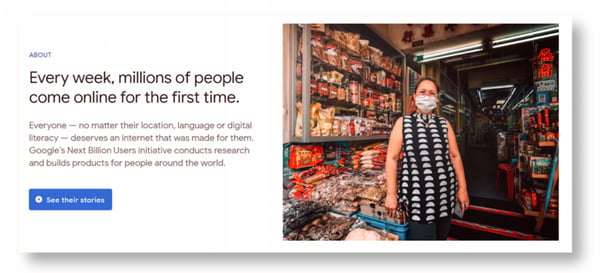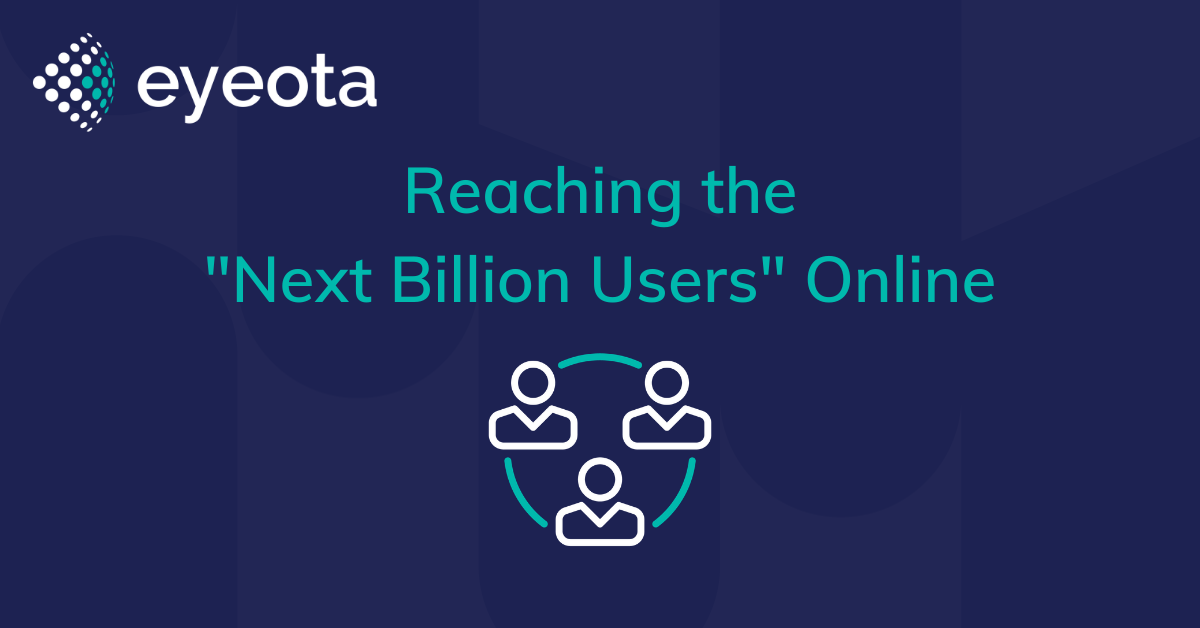Now more than ever, global brands are thinking about the “next billion users”. Google being one of the first. Back in 2015, Google CEO Sundar Pichai started the Next Billion Users (NBU) initiative to research the needs of these new user groups.
 [Screenshot from the homepage of nextbillionusers.google]
[Screenshot from the homepage of nextbillionusers.google]
The term “next billion users” caught on and it’s now used more generally to refer to an ever-growing pool of new audiences. A lot of them are based in developing economies which previously had low internet penetration. But not exclusively. Thanks to the pandemic, even “digitally saturated” markets such as the US and the UK saw new demographics come online.
Due to lockdown restrictions, many communities switched to meeting virtually and online platforms such as Zoom and Slack acquired swathes of new users. Social services like education and healthcare also quickly moved online as schools shut down and in-person doctor’s appointments were limited. This seismic change inevitably brought new users who were previously “disconnected” or rarely online, such as senior citizens and those from less privileged communities.
Whatever the reasons for coming online, one thing is certain: these new users behave differently from digital natives. They are often onboarded by word of mouth and rarely use mainstream social media platforms.
This requires a change in thinking when it comes to online advertising and site personalization. Especially if you work in the digital department of a global brand like Unilever or P&G. When these audiences come online, you want to reach them with messaging that’s consistent and targeted. You also want to make sure that your online services are tailored to their needs.
The most effective way to acquire and keep these potential new customers is to leverage audience data. For a long time now, brands have been focused on understanding their existing customers, but the focus is changing. If you work in digital marketing, you might have noticed a shift in emphasis towards acquiring more customers rather than keeping the existing ones.
Companies are investing more in the science of acquiring customers faster and more efficiently — especially customers who are more likely to remain loyal. To this end, global brands are building up their in-house data teams and developing more sophisticated, omnichannel data strategies.
However, their big challenge is acquiring those customers while knowing little about their online preferences. After all, these are audiences who have rarely been seen online before. They don’t have any digital data footprint. Nevertheless, they still have an overall data footprint. The only catch is that this data is mostly trapped in offline databases. These databases typically store details about purchase transactions and loyal scheme participation. Of course, you can still bring in that wealth of offline data with the help of data onboarding.
For instance, a grandma who only just signed up for an email address in 2020 isn't necessarily an unknown quantity. If you can onboard her offline data, you might know that she regularly orders orthopedic products over the phone in response to brochures that regularly appear in her letterbox. With this information, you can personalize your site to her requirements. The same principle applies to many niche audience segments that are emerging all over the world.
However, the devil is in the details. Onboarding relies on the availability of common attributes in both the online and offline data. For customers who are digital natives, an email address might be a fairly reliable matching criterion. For the grandma in our previous example, that won't work. Her offline data is not associated with any email address—she only just signed up for one. So you need to look for alternative attributes that you can use instead. And that's just for one person in one market. Doing this work on a global scale is a phenomenally difficult task.
This is why you might struggle to address these new customer segments, even if you’re in a data literate organization. Many disparate disciplines are involved in addressing customers such as SEO, programmatic advertising, consumer research and content marketing. But how many of these teams are still siloed in their own departments? If you’re in a complex organization with many siloed data sources, it can be difficult to take stock of your total data inventory and tie it together effectively.
But you’ll need to adapt if you want to ride the waves of “new-to-online” customers. You’ll need to find a consistent source of truth that works across all of your different data repositories. And that’s the problem that Eyeota originally set out to solve, so that brands can use technology to efficiently address a myriad of niche audiences on a global scale.
We have years of experience in helping major global brands expand into new markets. That means we’re well placed to help brands overcome technical challenges involved in onboarding data for markets where many users are only just coming online. So your future customers don’t have to be invisible to your personalization algorithms. When one of the next billion users comes to visit, you’ll be ready for them.
